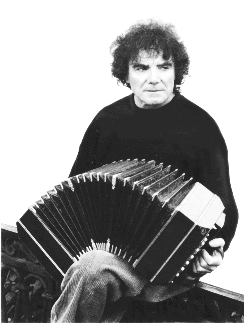
Luis Di Matteo was born on May 10, 1934. He began learning bandoneon as
as a child and autodidact and completed later his musical education at the
conservatory in his native city Montevideo, Uruguay. His professional
carreer began in the 50ies with the Trio of César Zagnoli in Montevideo
making recordings for Sondor and Antar Telefunken of Uruguay. He demonstrated
a remarcable security in his interpretations following an evolutive
instrumental style, particular ideas in composition and surprising
variations on the bandoneon.
In 1962 he founded his first own trio with his partners Eduardo de la Puente,
piano and Néstor Casco, contrabass acting for tv programmes.
In 1980 he gave his first performances in Europe.
Between 1983 and 1986 he cooperated with the music conservatory of
Detmold, Germany.
In 1987 he wrote the music for the swedish filmproduction
Black Dawn / Los Dueños del Silencio.
In 1900/91 he took for the first time the opportunity to work
and record with a string orquestra.
In the russian city of Uljanowsk (Lenin's birthplace) he recorded
own compositions with the chamber soloists of the
Uljanowsk National Symphony Orquestra.
The premier of his latest
major composition Concierto para contrabajo y orquesta de cuerdas
(Concert for doublebass and string orquestra), performed by the
Montevideo Philharmonic Orquestra, took place in Montevideo in the
summer of 1995.
The combination of strings and bandoneon have had a long tradition in South
America: during the triumphal career of the bandoneon since the beginning
of the century, mainly as the Orquesta Típica (bandoneons,
violins, double bass and piano). However, Di Matteo's intensive
collaboration with strings denotes a decisive step forward in the
developement of bandoneon music beyond the traditional limits established
by the tango music finding a form of personal expression that clearly places
him within the western music tradition in his compositions for this rather
difficult instrument.
Di Matteo has not only been influenced by traditional south american music but also increasingly by classical music, including the modern masters such as Arnold Schönberg. With his compositions for bandoneon and strings he opens our eyes for a new look at the bandoneon's possibilities of expression.